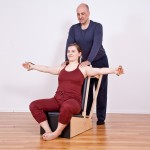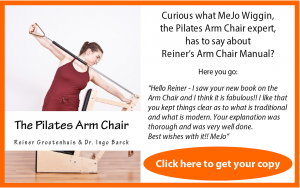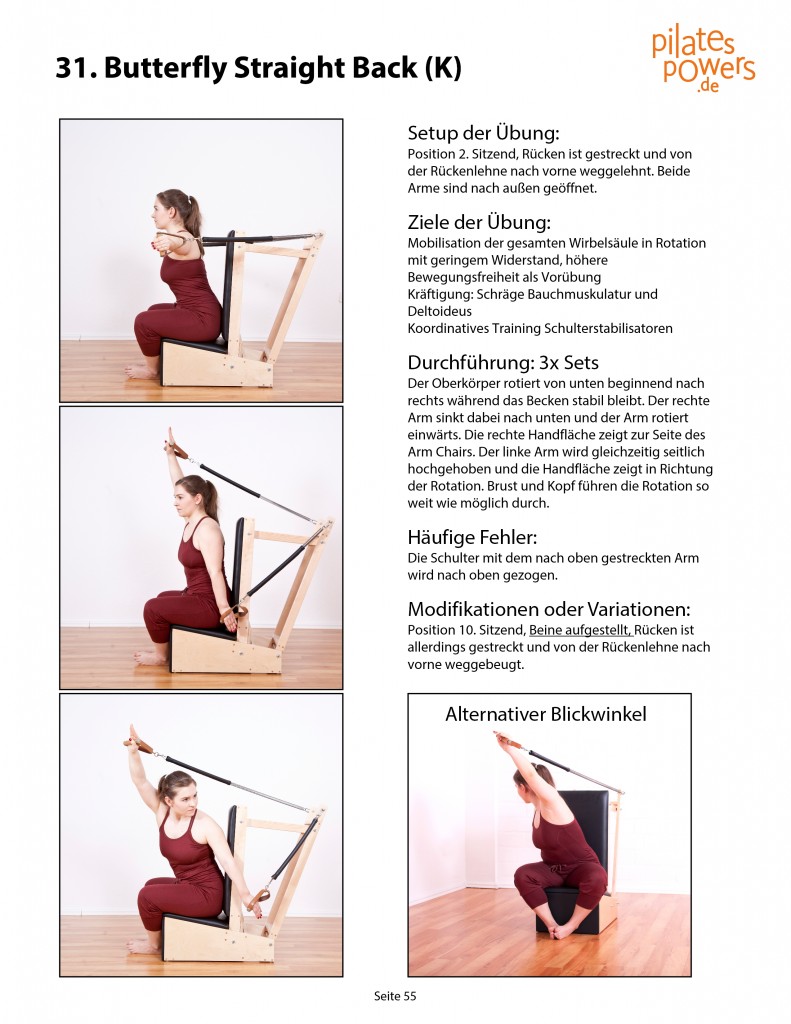The Baby Chair – not a Chair for Babies
by Reiner Grootenhuis
My first contact with an Arm Chair was an unusual one. The studio I was trained at had one of these rather huge Balanced Body Avalon Arm Chairs. So I was quite surprised when I saw a video by Gratz where they showed their factory at the time and a guy was building one of these kind of “tiny” traditional Arm Chairs. What a difference in size! But also, why was the backrest moveable? I was intrigued to learn more.
I found out that the Arm Chair – also sometimes called Baby Chair – is a simple construction that offers multiple training possibilities. The name Baby Chair probably comes from its springs which are sometimes called Baby Arm Springs or Baby Springs. Usually they are the lightest springs in a traditional studio. Due to its construction and the light springs, the Arm Chair is also suitable for those with physical limitations, so that they can work out without excessive demand.
The Arm Chair is especially well-known for its use with elderly clients or those who have neck or shoulder injuries. Since the shoulder joint is mostly stabilized by muscles, the joint health and prevention depends on the balance and proper interaction of the muscles. The Arm Chair with its versatile exercises works wonders in improving the functional stabilization of the shoulder joints.
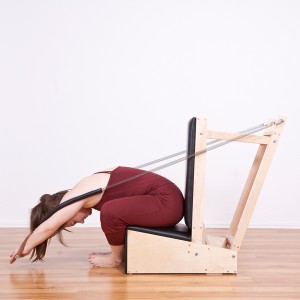 Unfortunately, not much is known about the origin of the Baby Chair. For example, you will not find the Arm Chair in any of Chuck Rapoport’s pictures. Yet, it is certain that it was already in use in Joseph Pilates’ studio, according to Hubertus Joseph Pilates – The Biography (by Esperanza Aparicio Romero and Javier Pérez Pont). They report that Joseph Pilates tried to record his work towards the end of his life and created a series of 12 films. The fourth of these films shows exercises with the Baby Chair. Most reports about the Arm Chair stem from teachers that have studied under Romana Kryzanowska, such as MeJo Wiggin or Kathi Ross Nash. They reveal that Romana Kryzanowska’s Arm Chair was mostly used by elderly ladies, which is how it earned another nickname –”old woman’s chair.”
Unfortunately, not much is known about the origin of the Baby Chair. For example, you will not find the Arm Chair in any of Chuck Rapoport’s pictures. Yet, it is certain that it was already in use in Joseph Pilates’ studio, according to Hubertus Joseph Pilates – The Biography (by Esperanza Aparicio Romero and Javier Pérez Pont). They report that Joseph Pilates tried to record his work towards the end of his life and created a series of 12 films. The fourth of these films shows exercises with the Baby Chair. Most reports about the Arm Chair stem from teachers that have studied under Romana Kryzanowska, such as MeJo Wiggin or Kathi Ross Nash. They reveal that Romana Kryzanowska’s Arm Chair was mostly used by elderly ladies, which is how it earned another nickname –”old woman’s chair.”
Despite several efforts to revive the Arm Chair with new exercises, the Arm Chair as a piece of Pilates equipment has nearly been forgotten about and hardly any Pilates studio has one. Thus, the knowledge about the Arm Chair has become rather limited. As an example, consider the video content available on Pilates Anytime. Let’s assume that the material on this very successful website aligns with our interests as Pilates instructors. As of September 2016, Pilates Anytime offered 2,343 Pilates videos, with only 4 of these being about the Arm Chair. This is less than 0.2%!
To be honest, I was unsure for quite some time whether I should buy an Arm Chair for my studio. Although I had already been acquainted with a modern form of the Arm Chair during my studio education, I thought that I could perform the exercises I had learned with light arm springs and a Reformer Sitting Box just as well. Back then, I was not aware of the importance of the support of the back and especially of the feedback for the shoulders given by the backrest on the “traditional” Arm Chair.
Today, I am very happy that I chose to get a “traditional” Arm Chair as it is the perfect addition for training with my private clients. Due to the feedback the Arm Chair provides directly to the client, my job as a teacher gets easier. Note: I also own a BASI Arm Chair Ladder Barrel.
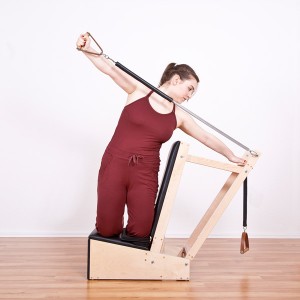 The springs of the traditional Arm Chair are placed a little towards the back and connected to the backrest of the Arm Chair. The backrest is movable and follows the forward movement of the user. Thus, if one shifts one’s center of gravity towards the front, the springs and the backrest follow, thereby keeping the spring tension on the same level during the movement. Modern versions have no movable backrest and a higher front edge of the seat. They also offer the possibility of connecting springs of different strength to the device using a metal rod attached to the back on both sides.
The springs of the traditional Arm Chair are placed a little towards the back and connected to the backrest of the Arm Chair. The backrest is movable and follows the forward movement of the user. Thus, if one shifts one’s center of gravity towards the front, the springs and the backrest follow, thereby keeping the spring tension on the same level during the movement. Modern versions have no movable backrest and a higher front edge of the seat. They also offer the possibility of connecting springs of different strength to the device using a metal rod attached to the back on both sides.
The traditional Arm Chair also presents some ideal conditions for instructors that facilitate assisting their clients. For instance, during the sitting position, the instructor can stand behind the Arm Chair and observe how the shoulders behave. If the shoulders, for example, become detached during the Arm Circles, the instructor can hold the shoulders from the top with both hands to help them stay in contact with the backrest throughout the exercise. When watching a person from the front during an exercise, the instructor can observe whether the client tilts to the right or to the left. This is especially helpful when training clients with scoliosis.
The results of my work with the Arm Chair have been really impressive for my clients. A lot of the clients who start working with me have a hard time using their shoulder girdle appropriately for the task they want to execute such as pulling their shoulders up while lifting something or rolling their shoulder completely forward when typing on a key board. I am pretty sure most of you have seen similar things. Re-patterning with the Arm Chair really changes the way they use their arms and shoulders, making the complaints about their shoulder hurting from their daily life activities reduce from session to session.
I guess you have figured out that I am in love with this piece of equipment! My love for the Arm Chair has even reached the level that I had the audacity to write a manual for it, since I found no publicly available one. I thought, as it is my second manual, it would be comparatively easy. Oh boy, was I in for a surprise.
It would be a great pleasure for me if you shared my enthusiasm for the Arm Chair after reading this article and tried an Arm Chair. The easiest approach might be to visit a colleague’s studio who has one or to join one of the Pilates “Icons of the Arm Chair” at a workshop.
And, if you already have an Arm Chair, don’t forget to get my manual 😉
 Besides obtaining a diploma in psychology and an MBA, Reiner Grootenhuis has studied the healing and martial arts of the Southern Shaolin Monastery Weng Chun. He completed the training as a Pilates instructor for Pilates mat and equipment at the Pilates educational academy BASI® (Body Arts & Science International). He is the founder and operator of the largest Pilates forum worldwide, pilates-contrology-forum on Facebook, which includes 7,000 Pilates instructors. At the beginning of 2012, he opened the pilates-powers Studio in Tönisvorst. 2014 Kathy Corey appointed him a member of the Board of Directors of the Pilates Heritage Congress, which takes place every two years in the hometown of Joseph Pilates. In 2015, he published the first publicly available German training manual on the Wunda Chair and 2016 an Arm Chair manual. Since January 2016, he has been studying the finesse of the method within the Kathy Corey mentor program.
Besides obtaining a diploma in psychology and an MBA, Reiner Grootenhuis has studied the healing and martial arts of the Southern Shaolin Monastery Weng Chun. He completed the training as a Pilates instructor for Pilates mat and equipment at the Pilates educational academy BASI® (Body Arts & Science International). He is the founder and operator of the largest Pilates forum worldwide, pilates-contrology-forum on Facebook, which includes 7,000 Pilates instructors. At the beginning of 2012, he opened the pilates-powers Studio in Tönisvorst. 2014 Kathy Corey appointed him a member of the Board of Directors of the Pilates Heritage Congress, which takes place every two years in the hometown of Joseph Pilates. In 2015, he published the first publicly available German training manual on the Wunda Chair and 2016 an Arm Chair manual. Since January 2016, he has been studying the finesse of the method within the Kathy Corey mentor program.

